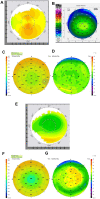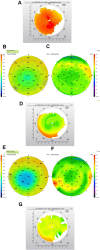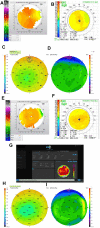Analysis and Causation of All Inaccurate Outcomes After WaveLight Contoura LASIK with LYRA Protocol
- PMID: 33223821
- PMCID: PMC7672711
- DOI: 10.2147/OPTH.S267091
Analysis and Causation of All Inaccurate Outcomes After WaveLight Contoura LASIK with LYRA Protocol
Abstract
Purpose: This study analyzes every eye that had an outcome greater than 0.25D of sphere or astigmatism from planned goal after treatment with WaveLight Contoura with LYRA Protocol.
Methods: The study included 266 consecutive eyes treated with LASIK Contoura using the LYRA Protocol. All LASIK procedures were performed on the WaveLight EX500 excimer laser. Flaps were created with either the Alcon WaveLight FS200 femtosecond laser or the Moria M2 microkeratome. Eyes that were off by >0.25 diopters (D) sphere or cylinder from the targeted goal within 3 months after surgery were identified and analyzed for cause. Topographical, higher-order aberration, and epithelial maps were created.
Results: Causes for inaccurate outcomes were biomechanical corneal change from LASK flap creation (9.78% of total eyes), pre-operative epithelial compensation of corneal higher-order aberration (4.1% of total eyes), changes to lamellar corneal tension from laser ablation causing a hyperopic shift (1.9% of total eyes), epithelial thickening over the ablation area post-operatively causing a refractive change (1.5% of total eyes), and posterior astigmatism (0.75%).
Conclusion: The causes of the majority of inaccurate outcomes have not been properly defined and must be incorporated into further improving outcomes. Current and planned advances in technology do not address the majority of these causes.
Keywords: LASIK; astigmatism; corneal epithelium; femtosecond laser; higher-order aberration; refractive error; Contoura; topography guided ablation; LYRA protocol.
© 2020 Motwani.
Conflict of interest statement
Dr. Motwani has received a grant from Alcon for a previous unrelated study in 2017. Dr. Motwani received non-financial support from Optovue, Inc. (loan of Optovue Avanti, clinical support in understanding analysis of data). Dr. Motwani has a patent pending on a theoretical device that could combine corneal HOA data and epithelial thickness data to achieve a more accurate refractive outcome. The author reports no other potential conflicts of interest for this work.
Figures






Similar articles
-
Biomechanical Changes to the Cornea from LASIK Flap Creation Resulting in Inaccurate Ablations and Suboptimal Refractive Outcomes with Topographic-Guided Ablation.Clin Ophthalmol. 2020 Aug 12;14:2319-2327. doi: 10.2147/OPTH.S263896. eCollection 2020. Clin Ophthalmol. 2020. PMID: 32848360 Free PMC article.
-
The use of WaveLight® Contoura to create a uniform cornea: the LYRA Protocol. Part 3: the results of 50 treated eyes.Clin Ophthalmol. 2017 May 16;11:915-921. doi: 10.2147/OPTH.S133841. eCollection 2017. Clin Ophthalmol. 2017. PMID: 28553071 Free PMC article.
-
Topographic-guided treatment of hyperopic corrections with a combination of higher order aberration removal with WaveLight® Contoura and wavefront-optimized hyperopic treatment.Clin Ophthalmol. 2018 Jun 1;12:1021-1029. doi: 10.2147/OPTH.S162511. eCollection 2018. Clin Ophthalmol. 2018. PMID: 29910599 Free PMC article.
-
Primary Topography-Guided LASIK: Refractive, Visual, and Subjective Quality of Vision Outcomes for Astigmatism ⩾2.00 Diopters.J Refract Surg. 2019 Feb 1;35(2):78-86. doi: 10.3928/1081597X-20181210-01. J Refract Surg. 2019. PMID: 30742221
-
Comparison of Wavefront-Optimized Ablation and Topography-Guided Contoura Ablation With LYRA Protocol in LASIK.J Refract Surg. 2019 Apr 1;35(4):222-229. doi: 10.3928/1081597X-20190304-02. J Refract Surg. 2019. PMID: 30984979
Cited by
-
Clinical Outcomes After Topography-guided Refractive Surgery in Eyes with Myopia and Astigmatism-Comparing Results with New Planning Software to Those Obtained Using the Manifest Refraction [Letter].Clin Ophthalmol. 2021 Feb 10;15:491-493. doi: 10.2147/OPTH.S298406. eCollection 2021. Clin Ophthalmol. 2021. PMID: 33603326 Free PMC article. No abstract available.
-
Application of Surgical Protocols for the Treatment of Highly Irregular Astigmatism with Topographic Guided Ablation in a Case of Post-LASIK Ectasia.Int Med Case Rep J. 2025 Jan 15;18:91-98. doi: 10.2147/IMCRJ.S476407. eCollection 2025. Int Med Case Rep J. 2025. PMID: 39830041 Free PMC article.
-
Understanding Variable Biologic-Based Factors in Determining Laser Refractive Surgery Outcomes: A Response to the Moshirfar et al Paper [Letter].Clin Ophthalmol. 2023 Oct 18;17:3087-3088. doi: 10.2147/OPTH.S441200. eCollection 2023. Clin Ophthalmol. 2023. PMID: 37873055 Free PMC article. No abstract available.
-
A Novel Procedure for Keratoconus/Corneal Ectasia Treating Epithelial Compensation of Higher-Order Aberrations, Topographic Guided Ablation, and Corneal Cross Linking - The CREATE+CXL Protocol.Clin Ophthalmol. 2023 Jul 13;17:1981-1992. doi: 10.2147/OPTH.S411472. eCollection 2023. Clin Ophthalmol. 2023. PMID: 37469861 Free PMC article.
References
LinkOut - more resources
Full Text Sources

